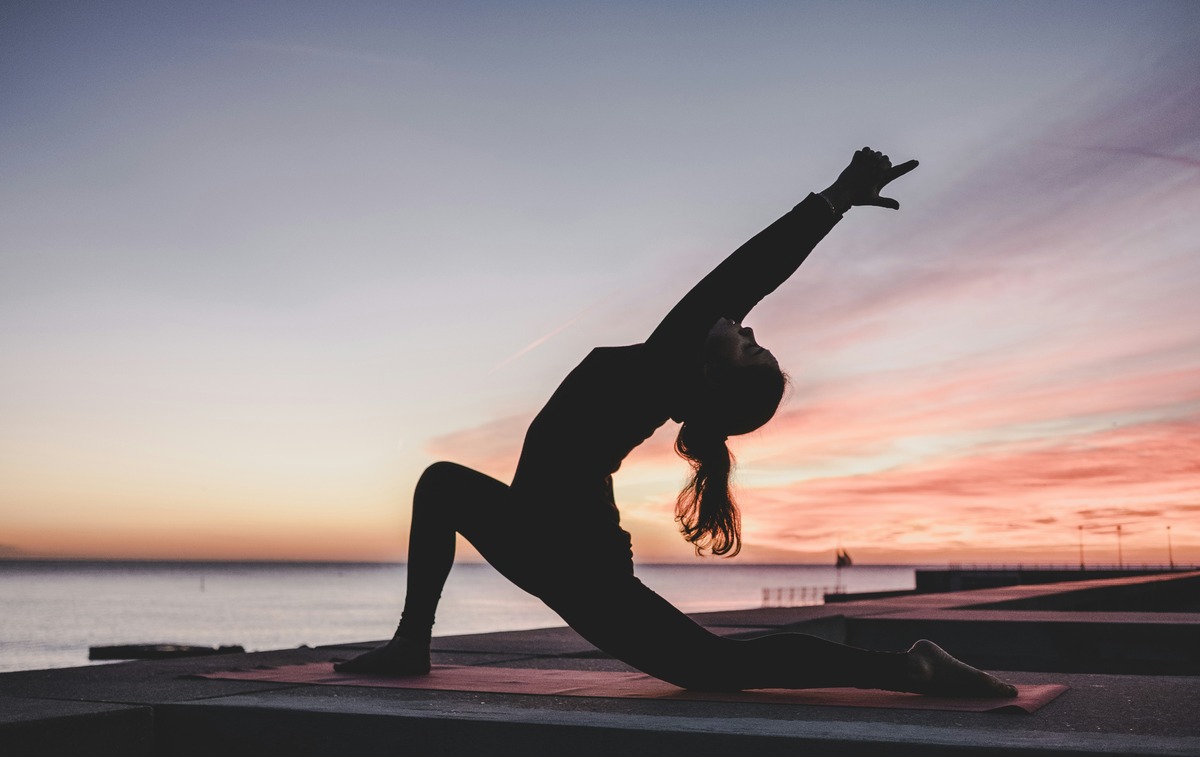Home>Health and Wellness>Unlock The Secret To Relieving Psoas Muscle Tightness While Sleeping And Sitting


Health and Wellness
Unlock The Secret To Relieving Psoas Muscle Tightness While Sleeping And Sitting
Published: February 12, 2024
Discover effective techniques for relieving psoas muscle tightness while sleeping and sitting. Improve your health and wellness with these simple strategies. Unlock the secret now!
(Many of the links in this article redirect to a specific reviewed product. Your purchase of these products through affiliate links helps to generate commission for Noodls.com, at no extra cost. Learn more)
Table of Contents
Introduction
Welcome to the ultimate guide on relieving psoas muscle tightness while sleeping and sitting. If you've ever experienced discomfort or stiffness in your lower back, hips, or pelvis, chances are your psoas muscle might be the culprit. The psoas muscle, also known as the "muscle of the soul" in yoga, plays a crucial role in our daily movements, yet it often goes unnoticed until it starts causing discomfort.
In this comprehensive guide, we will delve into the intricate details of the psoas muscle, uncover the common causes of tightness, explore the potential effects of this condition, and most importantly, equip you with practical tips to alleviate psoas muscle tightness while sleeping and sitting. Whether you're a dedicated yogi, an office worker spending long hours at a desk, or someone simply seeking relief from lower back and hip discomfort, this guide is tailored to help you understand and address the challenges posed by a tight psoas muscle.
So, grab your favorite beverage, find a comfortable spot, and let's embark on a journey to unlock the secrets of relieving psoas muscle tightness, allowing you to reclaim comfort and mobility in your daily life.
Understanding the Psoas Muscle
The psoas muscle, often referred to as the "muscle of the soul" in yoga and bodywork circles, is a deep-seated core muscle that plays a pivotal role in our body's movement and stability. This muscle, pronounced as "soh-az," is actually a group of muscles, with the primary players being the psoas major and the iliacus. These muscles are situated deep within the abdominal cavity, connecting the lumbar vertebrae to the top of the thigh bone, or femur.
The psoas muscle is integral to our daily movements, as it enables us to flex our hips, lift our legs, and bend at the waist. It also plays a crucial role in stabilizing the spine and pelvis, contributing to our overall posture and alignment. Moreover, the psoas muscle is intricately linked to our fight-or-flight response, as it is connected to the diaphragm and the deep core muscles, influencing our breath and emotional state.
Due to its deep location and its involvement in various bodily functions, the psoas muscle can easily become tight and constricted. Factors such as prolonged sitting, sedentary lifestyles, stress, and repetitive movements can contribute to the tightening of the psoas muscle, leading to discomfort and restricted mobility.
Understanding the psoas muscle and its significance in our daily lives is the first step toward addressing any discomfort or tightness associated with it. By gaining insights into its anatomy, function, and potential impact on our well-being, we can better appreciate the importance of maintaining a healthy and supple psoas muscle. This understanding sets the stage for exploring effective strategies to relieve psoas muscle tightness while sleeping and sitting, empowering us to take proactive steps toward improved comfort and mobility.
Causes of Psoas Muscle Tightness
Psoas muscle tightness can stem from various lifestyle factors and habits, often leading to discomfort and restricted mobility. Understanding the potential causes of this tightness is crucial in addressing the underlying issues and implementing effective strategies for relief.
-
Prolonged Sitting: In today's predominantly sedentary lifestyle, prolonged sitting has become a common culprit behind psoas muscle tightness. Whether it's spending extended hours at a desk, commuting long distances, or engaging in activities that involve sitting for extended periods, the psoas muscle can become chronically shortened and tight, leading to discomfort in the lower back and hips.
-
Lack of Movement: A lack of regular movement and physical activity can contribute to psoas muscle tightness. When the psoas muscle remains in a shortened position for prolonged periods, such as during long periods of inactivity, it can become tight and constricted, impacting overall flexibility and mobility.
-
Emotional Stress: The psoas muscle is intricately linked to our emotional well-being and stress response. Emotional tension and stress can manifest physically, leading to the tightening of the psoas muscle. This can create a cycle of discomfort, as tightness in the psoas muscle can, in turn, contribute to increased stress and emotional tension.
-
Improper Posture: Poor posture, whether while sitting, standing, or moving, can place undue stress on the psoas muscle, leading to chronic tightness and discomfort. Slouching or hunching over can cause the psoas muscle to adapt to a shortened position, contributing to ongoing tightness and potential pain in the lower back and hips.
-
Repetitive Movements: Engaging in repetitive movements or activities that predominantly involve the use of the hip flexors, such as cycling, running, or excessive abdominal exercises, can lead to overuse and tightening of the psoas muscle. This can result in discomfort and restricted range of motion in the hip area.
By recognizing these common causes of psoas muscle tightness, individuals can take proactive steps to address these contributing factors and implement targeted strategies to alleviate discomfort and restore flexibility in the psoas muscle. Whether through mindful movement, stress-reducing practices, or postural awareness, understanding the root causes of psoas muscle tightness empowers individuals to make informed choices for their overall well-being.
Effects of Psoas Muscle Tightness
The effects of psoas muscle tightness can permeate various aspects of our physical and emotional well-being, exerting a significant impact on our daily lives. Understanding these effects is crucial in recognizing the far-reaching implications of a tight psoas muscle and the importance of addressing it effectively.
Physical Discomfort and Restricted Mobility
One of the most immediate effects of psoas muscle tightness is the onset of physical discomfort and restricted mobility. Tightness in the psoas muscle can manifest as persistent lower back pain, hip stiffness, and limited range of motion in the hips and pelvis. Individuals may experience difficulty in performing activities that require hip flexion, such as walking, climbing stairs, or engaging in physical exercise. This physical discomfort can significantly impede daily movements and diminish overall quality of life.
Read more: Unlock The Secret Meaning Of Late Morning
Altered Posture and Alignment
The psoas muscle plays a pivotal role in maintaining proper posture and spinal alignment. When this muscle becomes tight and constricted, it can exert a pull on the lower spine, leading to an anterior pelvic tilt. This altered pelvic position can contribute to an exaggerated lumbar curve, commonly known as hyperlordosis, which may further exacerbate lower back pain and discomfort. Additionally, the effects of psoas muscle tightness on posture can extend to the entire kinetic chain, potentially impacting the alignment of the hips, knees, and ankles.
Impaired Breathing and Diaphragmatic Function
As the psoas muscle is intricately connected to the diaphragm, its tightness can impede diaphragmatic movement and hinder optimal breathing patterns. A tight psoas muscle may restrict the downward movement of the diaphragm during inhalation, leading to shallow breathing and diminished respiratory efficiency. This can contribute to feelings of breathlessness, increased tension in the chest and shoulders, and a heightened state of stress and anxiety.
Emotional Tension and Stress
The psoas muscle is often referred to as the "muscle of the soul" due to its association with emotional well-being and the fight-or-flight response. When the psoas muscle is tight, it can perpetuate a cycle of emotional tension and stress. Physical discomfort in the lower back and hips, coupled with impaired breathing, can contribute to heightened emotional reactivity and a sense of unease. Addressing psoas muscle tightness can have a profound impact on emotional well-being, potentially alleviating stress and promoting a sense of calm and groundedness.
Digestive and Pelvic Floor Implications
The psoas muscle's proximity to the digestive organs and its influence on pelvic stability can also give rise to digestive and pelvic floor implications when tight. Constriction in the psoas muscle may impact the functioning of the digestive system and contribute to discomfort in the abdominal region. Furthermore, its connection to the pelvic floor muscles underscores the potential influence of psoas muscle tightness on pelvic floor function and overall pelvic health.
By recognizing the multifaceted effects of psoas muscle tightness, individuals can appreciate the interconnected nature of physical, emotional, and physiological well-being. Addressing these effects through targeted strategies aimed at relieving psoas muscle tightness while sleeping and sitting can pave the way for enhanced comfort, mobility, and overall vitality.
Read more: Unlock The Secret To SSI Insurance With BNC#
Relieving Psoas Muscle Tightness While Sleeping
Addressing psoas muscle tightness while sleeping is crucial for promoting relaxation, supporting optimal posture, and facilitating the release of tension accumulated throughout the day. Here are practical strategies to alleviate psoas muscle tightness during sleep:
Supportive Sleep Positioning
Optimizing sleep positioning can significantly contribute to relieving psoas muscle tightness. When lying on your back, consider placing a pillow or cushion under your knees. This gentle elevation can help release tension in the psoas muscle by reducing the degree of hip flexion, promoting a more neutral pelvic position, and alleviating strain on the lower back. Additionally, side sleepers can benefit from placing a pillow between their knees to support proper alignment and minimize stress on the psoas muscle.
Gentle Stretching Before Bed
Incorporating gentle stretching exercises targeting the hip flexors and psoas muscle before bedtime can promote relaxation and alleviate tightness. Simple stretches such as the low lunge or kneeling hip flexor stretch can help release tension in the psoas muscle, preparing it for a more comfortable and relaxed state during sleep. Engaging in these stretches mindfully and gradually can contribute to improved flexibility and reduced tightness in the psoas muscle over time.
Mindful Breathing and Relaxation Techniques
Practicing deep breathing and relaxation techniques before sleep can aid in releasing tension in the psoas muscle and promoting overall relaxation. Mindful diaphragmatic breathing, where the breath is directed toward the lower abdomen, can help release tension in the psoas muscle and promote a sense of ease and comfort. Additionally, incorporating progressive muscle relaxation or gentle yoga nidra practices can further support the release of muscular tension, including that of the psoas muscle, fostering a more restful and rejuvenating sleep experience.
Supportive Mattress and Pillows
Investing in a supportive mattress and pillows can contribute to alleviating psoas muscle tightness while sleeping. A mattress that provides adequate support and promotes spinal alignment can help reduce pressure on the psoas muscle and lower back, facilitating a more comfortable and restorative sleep environment. Similarly, using pillows that offer proper neck and lumbar support can aid in maintaining optimal posture and minimizing strain on the psoas muscle during sleep.
By integrating these strategies into your bedtime routine, you can effectively address psoas muscle tightness while sleeping, promoting relaxation, supporting optimal posture, and fostering a more rejuvenating and comfortable sleep experience. These practices can contribute to the gradual release of tension in the psoas muscle, ultimately enhancing overall comfort and mobility in your daily life.
Relieving Psoas Muscle Tightness While Sitting
Addressing psoas muscle tightness while sitting is essential for individuals who spend prolonged periods in seated positions, whether at work, during commutes, or while engaging in leisure activities. The seated posture often places the psoas muscle in a chronically shortened position, contributing to tightness and discomfort. Implementing targeted strategies to relieve psoas muscle tightness while sitting can significantly enhance comfort, support optimal posture, and promote overall well-being.
Mindful Postural Awareness
Maintaining mindful postural awareness while sitting is fundamental in alleviating psoas muscle tightness. Individuals can benefit from sitting with their feet flat on the floor, knees at hip level, and maintaining a neutral spine. Engaging the core muscles and avoiding slouching or overarching the lower back can help reduce undue strain on the psoas muscle, promoting a more balanced and comfortable seated position.
Regular Movement Breaks
Incorporating regular movement breaks throughout prolonged periods of sitting can aid in relieving psoas muscle tightness. Taking brief breaks to stand, stretch, and walk can help counteract the effects of prolonged sitting on the psoas muscle. Simple movements such as gentle hip circles, standing forward bends, or walking for a few minutes can promote circulation, release tension in the psoas muscle, and support overall comfort and flexibility.
Read more: Unlock The Secret To Achieving 12-Pack Abs!
Seated Hip Flexor Stretch
Engaging in a seated hip flexor stretch can provide targeted relief for the psoas muscle while sitting. To perform this stretch, individuals can move to the edge of their seat, extend one leg behind them with the toes touching the floor, and gently lean forward, feeling a stretch in the front of the extended hip. Holding this stretch for 20-30 seconds on each side can help alleviate tightness in the psoas muscle and promote greater comfort while seated.
Ergonomic Support
Utilizing ergonomic support, such as a supportive chair or cushion, can contribute to relieving psoas muscle tightness while sitting. Chairs that provide lumbar support and promote proper pelvic alignment can help reduce strain on the psoas muscle and lower back. Additionally, using a cushion or bolster to elevate the hips slightly can aid in maintaining a more neutral pelvic position, alleviating pressure on the psoas muscle during prolonged sitting.
Mindful Breathing and Relaxation
Incorporating mindful breathing and relaxation techniques while sitting can support the release of tension in the psoas muscle. Individuals can practice deep diaphragmatic breathing, directing the breath toward the lower abdomen, to promote relaxation and alleviate tightness in the psoas muscle. Additionally, incorporating moments of mindful relaxation, such as gentle shoulder rolls or neck stretches, can further support the release of muscular tension, including that of the psoas muscle, while sitting.
By integrating these strategies into their seated routine, individuals can effectively address psoas muscle tightness, promoting comfort, supporting optimal posture, and fostering greater ease and mobility throughout their day. These practices can contribute to the gradual release of tension in the psoas muscle, ultimately enhancing overall well-being and vitality.
Conclusion
In conclusion, understanding the intricate nature of the psoas muscle and its impact on our daily lives is paramount in addressing the challenges posed by psoas muscle tightness. From the potential causes of tightness, including prolonged sitting, lack of movement, emotional stress, improper posture, and repetitive movements, to the multifaceted effects it can exert on physical, emotional, and physiological well-being, the significance of relieving psoas muscle tightness cannot be overstated.
By delving into practical strategies to alleviate psoas muscle tightness while sleeping and sitting, individuals can proactively address this common source of discomfort and restricted mobility. From supportive sleep positioning, gentle stretching, and mindful breathing techniques to mindful postural awareness, regular movement breaks, and ergonomic support while sitting, the comprehensive approach to relieving psoas muscle tightness empowers individuals to reclaim comfort and mobility in their daily lives.
Moreover, the recognition of the interconnected nature of physical and emotional well-being underscores the profound impact of addressing psoas muscle tightness. By promoting relaxation, supporting optimal posture, and fostering greater ease and mobility, the strategies outlined in this guide extend beyond mere physical relief, offering a pathway to enhanced overall vitality and well-being.
Ultimately, the journey to relieving psoas muscle tightness is a holistic endeavor, encompassing mindful movement, postural awareness, breath-centered practices, and a deep understanding of the body-mind connection. By integrating these strategies into daily routines, individuals can embark on a transformative path toward enhanced comfort, mobility, and overall well-being, unlocking the secrets to a supple and resilient psoas muscle that supports a vibrant and active lifestyle.











